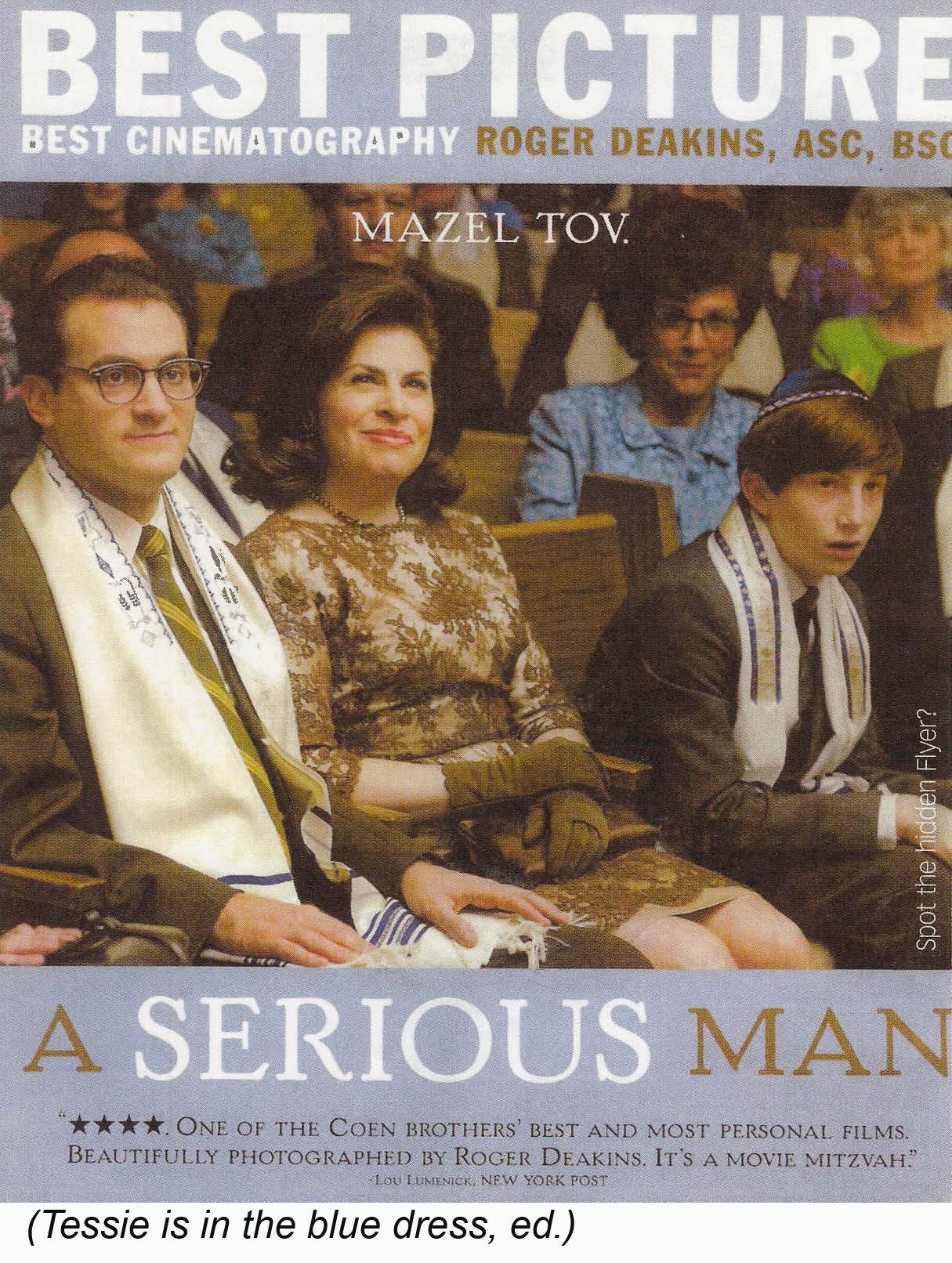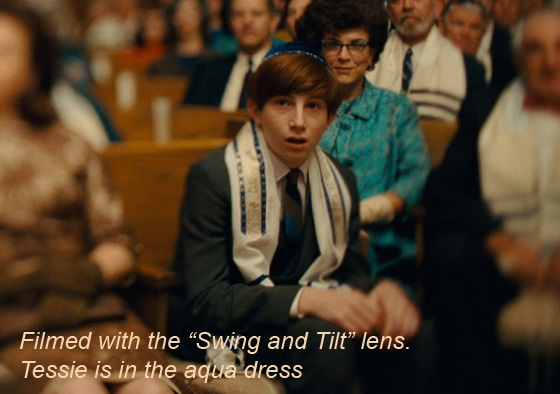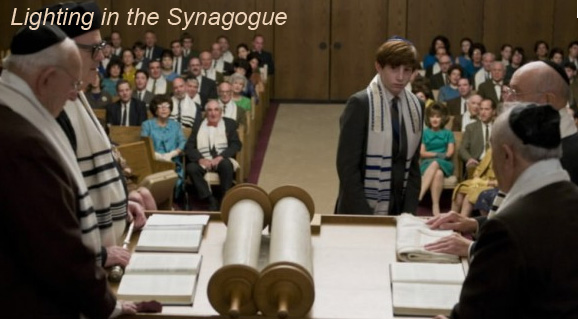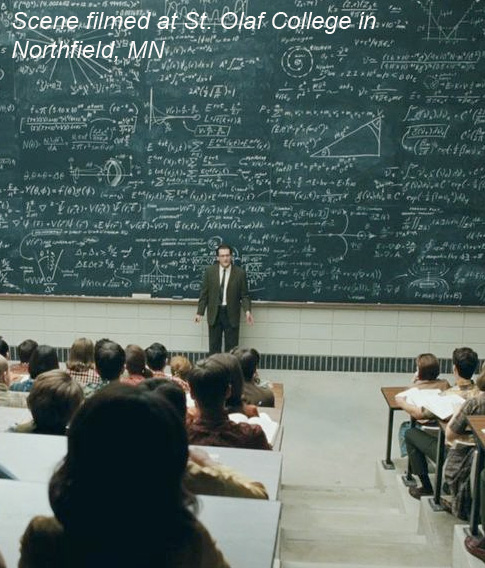On BEING AN EXTRA in A Serious Man
a movie written, produced, directed and edited by Joel and Ethan Coen
by Tessie Bundick
I was fortunate enough to be cast as an extra in two scenes - a funeral and a bar mitzvah. The movie was set in 1967, in the Midwest, and was very loosely based on the youthful years of Joel and Ethan Coen, who grew up in St. Louis Park, Minnesota.
I am a costume designer/make-up artist, so I was particularly interested in the wardrobe fittings with designer, Mary Zophres. Ms  Zophres has collaborated with the Coen Brothers on many of their films. She praises them on several levels- their wonderful sense of humor, their kindness, their fiscal responsibility, their organizational skills and so on. A Coen film is a calm film. She claims that their scripts are so evocative that she knows how the clothes should look after one reading.
Zophres has collaborated with the Coen Brothers on many of their films. She praises them on several levels- their wonderful sense of humor, their kindness, their fiscal responsibility, their organizational skills and so on. A Coen film is a calm film. She claims that their scripts are so evocative that she knows how the clothes should look after one reading.
Ms Zophres did a lot of research for this particular project by pouring through period photos at the Jewish Historical Society of the upper Midwest.
The protagonist of the film was a nerdy professor, so she put him in a lot of custom made short sleeved shirts and a pair of glasses. There were a lot of spectacles in this movie and she got many of them from a vintage clothing source in New Jersey. She also shopped at other vintage places such as Meow in Long Beach and Playclothes in North Hollywood.
Mary Zophres loves her work. She especially loves that moment when the actors' faces light up as they "see" their character during a fitting.
I really enjoyed watching her focus and concentration during my time with her. She takes a personal interest in the clothing of many of the people cast in these films. She chose everything that I wore with great consideration down to the shoes and earrings. I tried on several outfits until she decided on just the right ones for my two scenes. And she was absolutely right in those choices. She made sure that just about all of the women in the film wore long line bras and girdles that were a bit too small, so that we would all sit up straight and have good postures as ladies did in the 1960's. I thought it was a great idea, and although it was uncomfortable, it really worked. After the costume sessions were concluded, we were sent to meet with a hair stylist. Many of the men had there hair shorn to a 1960's style and the women were told to NOT cut their hair.
The Coen Brothers often do an initial version of the storyboards before an artist draws them in more detail. The storyboards reflect a cutting pattern rather than exact compositions and are subject to changes. Things can differ as the reality of filming sets in, but the end product often reflects the final storyboard.
Roger Deakins, their director of photography and cinematographer, prefers simplicity, using natural sources for light, if possible. He feels that lighting should not draw attention to itself and force the viewer out of the film context. All is there to serve the movie characters and the text.
In one of the scenes in which I was lucky enough to get some good screen time, Mr. Deakins used what is called a "swing and tilt" lens to achieve an out of focus effect imparting a "stoned" feeling. (The ba r mitzvah boy, the central character in this segment, had indulged in a little "smoking" episode before the ceremony begins). These lenses allow the cinematographer to change the plane of focus and create a vignette effect. It keeps the attention on the same narrow area, while blurring the perimeter of the frame.
r mitzvah boy, the central character in this segment, had indulged in a little "smoking" episode before the ceremony begins). These lenses allow the cinematographer to change the plane of focus and create a vignette effect. It keeps the attention on the same narrow area, while blurring the perimeter of the frame.
The lighting for the large open space of the synagogue was tricky. The rig decided upon was a kind of chandelier composed of six concentric hexagonals fitted with 287 white incandescent bulbs. The bulb wattage  was 75. White sheets were draped about this contraption. In this manner, lots of good, strong, even light was dumped on the large gathering below for the funeral and the bar mitzvah scenes. The massive chandelier that had been previously in the sanctuary, was dismounted by a giant crane, and then, of course, restored when filming concluded.
was 75. White sheets were draped about this contraption. In this manner, lots of good, strong, even light was dumped on the large gathering below for the funeral and the bar mitzvah scenes. The massive chandelier that had been previously in the sanctuary, was dismounted by a giant crane, and then, of course, restored when filming concluded.
Mr. Deakins, also, feels that as many scenes as possible should be shot on location to give a feeling of authenticity to the final product. He claims that as little should be fixed in post production. All should strive to get it right while filming is going on. In "A Serious Man", there were times when trees had to be erased in post because the neighborhood where the protagonist lived needed to look newly built, as though it were a fresh 1960's suburb, with little landscaping in it yet.
My services were needed for three days in November. The extras were all to report to a large warehouse, a short distance from B'Nai Emet Synagogue in St. Louis Park. One very large room in the warehouse had been turned into a make-up area, complete with lighted mirrors, stands, chairs and outlets. Stylists were kept very busy teasing masses of hair, using lots of hair spray and applying 60's eyeliner. We changed into our costumes in a big common room. No chance for modesty, but no one seemed to mind. Most women brought comfortable shoes as our costume shoes were spiky high heels that could be a little painful.
We were driven to the set in buses and vans and placed in a large outdoor tent with lots of food and beverages while we waited to be  called to the set. Many of the extras seemed to know each other and there were several mini reunions.
called to the set. Many of the extras seemed to know each other and there were several mini reunions.
Being associated with this project was very fun. We filmed a lot in three days and were always treated with courtesy and respect. The Coen Brothers would come over and thank us and tell us how wonderful we all looked. Everything went very smoothly and flowed beautifully. I, personally, had a great time and was able to observe modem masters, the Coens and Roger Deakins, at work on a very up close and personal level.
"A Serious Man" went on to win many awards and was nominated for two Oscars, for best picture and best screenplay.
Tessie Bundick is a freelance costume designer/make-up artist located in Minneapolis, MN bundi003@umn.edu
